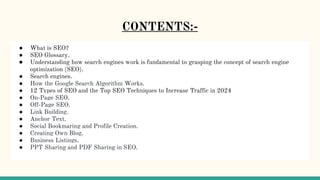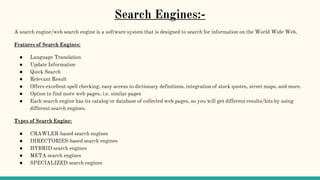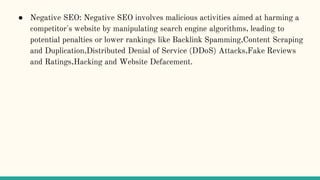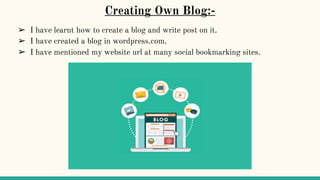Things I've learnt as an SEO Analyst.pdf
- 1. Things I’ve Learned as a SEO Analyst Created By:- Pratik Priyadarshi Webomaze Technologies
- 2. CONTENTS:- ● What is SEO? ● SEO Glossary. ● Understanding how search engines work is fundamental to grasping the concept of search engine optimization (SEO). ● Search engines. ● How the Google Search Algorithm Works. ● 12 Types of SEO and the Top SEO Techniques to Increase Traffic in 2024 ● On-Page SEO. ● Off-Page SEO. ● Link Building. ● Anchor Text. ● Social Bookmaring and Profile Creation. ● Creating Own Blog. ● Business Listings. ● PPT Sharing and PDF Sharing in SEO.
- 3. What is SEO? SEO stands for “search engine optimization.” In simple terms, SEO means the process of improving your website to increase its visibility in Google, Microsoft Bing, and other search engines whenever people search for: ● Products you sell. ● Services you provide. Information on topics in which you have deep expertise and/or experience. The better visibility your pages have in search results, the more likely you are to be found and clicked on. Ultimately, the goal of search engine optimization is to help attract website visitors who will become customers, clients or an audience that keeps coming back.
- 4. SEO Glossary:- The SEO Glossary is a list of terms and definitions related to search engine optimization, digital marketing. You can use this SEO glossary to understand the most common technical terms in the industry as well as some of the metrics.
- 5. Understanding how search engines work is fundamental to grasping the concept of search engine optimization (SEO). 1. Crawling: Crawling is the process by which search engines discover and collect information about web pages. Search engines use automated programs called crawlers or spiders to traverse the vast expanse of the internet and visit web pages. 2. Indexing: Indexing is the process of storing and organizing the information collected during the crawling phase. The indexed data forms a massive database, known as the search engine index. 3. Ranking: Ranking is the process of determining the order in which pages appear in the search engine results page (SERP) for a given query. Search engines employ complex algorithms to evaluate and rank pages based on relevance and authority. Crawling Indexing Ranking
- 6. Search Engines:- A search engine/web search engine is a software system that is designed to search for information on the World Wide Web. Features of Search Engines: ● Language Translation ● Update Information ● Quick Search ● Relevant Result ● Offers excellent spell checking, easy access to dictionary definitions, integration of stock quotes, street maps, and more. ● Option to find more web pages, i.e. similar pages ● Each search engine has its catalog or database of collected web pages, so you will get different results/hits by using different search engines. Types of Search Engine: ● CRAWLER-based search engines ● DIRECTORIES-based search engines ● HYBRID search engines ● META search engines ● SPECIALIZED search engines
- 7. How the Google Search Algorithm Works:- Google haven’t made their exact algorithm public to anyone.So, basically we have to work on the ranking factors that go into the algorithm. Google Ranking Process: ➢ First of all Google crawls pages and checks the page’s existence by following from a link or by the sitemap. ➢ Then Google indexes pages , Google checks the topic of the page and the page is unique or not because not every pages are indexed. ➢ Then the indexed pages are shown to the users when they run a query and this is the place where ranking algorithm comes in. Google organize the pages according to their relevance and helpfulness. Key Google Search Algorithm Ranking Factors? ● Content Relevance ● Content Quality ● User Experience ● Backlinks ● Topical Authority ● Context There are some disputed ranking factors are also present like domain age, bounce rate and domain authority.
- 8. 12 Types of SEO:- ● On-Page SEO (On-Site SEO): On-Page SEO is also known as On-Site SEO.We focus on the website's pages to improve its search engine rankings and enhance user experience like Content Optimization,Meta Tags,URL Structure,Header Tags,Keyword Placement. ● Off-Page SEO(Off-Site SEO):Off-Page SEO is the process in which the actions are taken outside the website’s page to improve its ranking and authority like Link Building,Social Media Engagement,Influencer Marketing,Guest Posting,Online Reputation Management. ● Technical SEO: It focuses on optimizing the website technically to make it more search engine-friendly and improve its crawlability, indexation, and overall performance like Website Speed Optimization,Mobile Responsiveness,XML Sitemaps,Canonicalization,SSL/HTTPS Implementation.
- 9. ● International SEO: It is done to target audiences in multiple countries, ensuring that it ranks well in various regions and languages , it includes Geotargeting,hreflang Tags,Content Localization,International Keyword Research,Multilingual SEO. ● Local SEO: Local SEO focuses on optimizing a website to appear in local search results, especially for businesses with physical locations or services targeting a specific geographic area like Google My Business Optimization,Local Citations,Local Link Building,Customer Reviews,Local Keyword Targeting. ● E-commerce SEO: It is done to optimize online stores, ensuring better visibility and higher rankings for product pages in search engine results like Product Page Optimization,User Experience (UX),Schema Markup for Products,Customer Reviews and Ratings,E-commerce Keyword Research. ● Content SEO: Content SEO focuses on creating high-quality, relevant, and optimized content to attract and engage users and improve search engine rankings like Keyword Research and Integration,Content Quality and Relevance,Content Formatting,Internal Linking,Evergreen Content Strategies.
- 10. ● Mobile SEO: It involves optimizing a website for mobile devices, ensuring that it provides a seamless and user-friendly experience on smartphones and tablets like Mobile-Friendly Design,Page Speed for Mobile,Mobile-Optimized Content,Responsive Design,Mobile Usability. ● White-Hat SEO: It refers to ethical and legitimate optimization techniques that comply with search engine guidelines and focus on providing value to users like Quality Content Creation,Ethical Link Building,Proper Keyword Usage,Transparency in Practices,Adherence to Search Engine Guidelines. ● Black-Hat SEO: Black-Hat SEO involves using unethical and manipulative techniques to achieve higher search engine rankings, often violating search engine guidelines like Keyword Stuffing,Cloaking,Link Farming,Hidden Text,Doorway Pages. ● Gray-Hat SEO: Gray-Hat SEO falls between White-Hat and Black-Hat SEO, incorporating both ethical and potentially risky techniques to achieve quicker results like Moderate Link Building,Guest Posting for Links,Aggressive Keyword Tactics,Content Automation,Social Media Automation.
- 11. ● Negative SEO: Negative SEO involves malicious activities aimed at harming a competitor's website by manipulating search engine algorithms, leading to potential penalties or lower rankings like Backlink Spamming,Content Scraping and Duplication,Distributed Denial of Service (DDoS) Attacks,Fake Reviews and Ratings,Hacking and Website Defacement.
- 12. On-Page SEO:- On-page SEO (also called on-site SEO) is the process of optimizing webpages and their content for both search engines and users. It can help rank pages higher on Google and drive more organic traffic. Common tasks associated with on-page SEO include optimizing for search intent, title tags, internal links, and URLs. Techniques: ● Write unique, helpful content ● Place target keywords strategically ● Write keyword-rich title tags ● Write click-worthy meta descriptions ● Use headings and subheadings to structure your page ● Optimize URLs ● Add internal links ● Add external links ● Include and optimize images
- 13. Off-Page SEO:- Off-page SEO refers to SEO tactics applied outside of a website to improve its rankings. These tactics often include link building, guest posting, social media marketing, and more. The goal of off-page SEO is to get search engines (and users) to see your site as more trustworthy and authoritative. Importance: Think about off-page SEO as building your site’s reputation. And highly reputable websites tend to rank better because search engines consider them to have more Expertise, Authoritativeness, and Trustworthiness (E-A-T). One of the best ways to show E-A-T is through off-page SEO factors like backlinks, reviews, and recommendations. Techniques: ● Link Building ● Content Marketing ● Local SEO (GMB and Citations) ● Reviews ● Events
- 14. Link Building:- Backlinks: When a Web Page links to any other page, it’s called a Backlink. Google and other major search engines consider backlinks “votes” for a specific page. Pages with a high number of backlinks tend to have high organic search engine rankings. Internal Links: Internal links, also known as inbound links, are hyperlinks that directs the reader to the target page on your website. Internal links on a web page will help a viewer to stay engaged with your website longer. This may encourage them to become a customer or follower. These links are more accessible to viewers, and they increase the authority of your web pages and overall site.
- 15. Outbound Links: Outbound links are hyperlinks that directs the reader to a reputable page on a different website. The quality and quantity of the external links that you use matters. Adding trustworthy and informative website links of high quality to your pages will help improve the credibility of your website. Outbound Linking SEO Advantage? Increased Expertise on any topic if you site is generic type.
- 16. Types Of Backlinks: There are two types of backlinks: ● Do-follow backlink ● No-follow backlink
- 17. Anchor Text:- Anchor text refers to the clickable text within a hyperlink. It provides context to both users and search engines about the content of the linked page. Properly optimized anchor text contributes to a webpage's search engine ranking and helps users understand the relevance of the linked content. Types of Anchor Text: ● Exact Match ● Partial Match ● Branded ● Naked URL ● Generic ● Image Anchor ● LSI (Latent Semantic Indexing)
- 18. Social Bookmaring and Profile Creation:- Social bookmarking is an online practice where users can save, organize, and share web pages and resources through a centralized platform. These platforms allow users to tag, categorize, and annotate bookmarks, making it easy to access and share valuable content. ➢ I have created accounts on social bookmarking sites and updated the description with my website link and checked the domain authority score and spam score of the URLs. ➢ I have created accounts on Reddit,folkd,diigo,tumblr,pinterest,flipboard,scoopit,bibsonomy,linktree,medium,issu u,TED,Firefox Add-ons,github,slideshare,dribble.
- 19. Creating Own Blog:- ➢ I have learnt how to create a blog and write post on it. ➢ I have created a blog in wordpress.com. ➢ I have mentioned my website url at many social bookmarking sites.
- 20. Business Listings:- In today’s digital age, having a strong online presence is crucial for businesses of all sizes. One effective way to enhance your visibility and attract local customers is through a local business listing. These directories serve as online platforms where businesses can showcase their products, services, and contact information. In this comprehensive guide, we will explore the benefits of local business listings, how they work, best practices for optimising your listings, popular platforms to consider, and the impact they can have on customer acquisition. Benefits of Local Business Listings: ● Increased Online Visibility ● Improved Local SEO ● Enhanced Brand Awareness Popular Local Business Listing Platforms: ● Google My Business ● Yelp ● Bing Places
- 21. PPT Sharing and PDF Sharing in SEO:- PPT Sharing: PPT sharing in SEO involves creating presentations in PowerPoint format and sharing them on various online platforms. These platforms often have a large user base, allowing you to reach a wider audience and potentially generate backlinks to your website. The platforms where we can share our ppt are slideshare,authorstream, or slideserve. Benefits: ● Increased visibility and reach. ● Potential backlinks to your website. ● Establishing authority and expertise in your industry. PDF Sharing: PDF sharing in SEO involves converting relevant content into PDF format and distributing it on various online platforms. This not only increases the visibility of your content but also provides opportunities for building backlinks. The platforms where we can share our ppt are slideshare,Issuu, or PDF-sharing communities within your niche. Benefits: ● Diversified content distribution. ● Potential for backlinks and increased website traffic. ● Improved SEO through content repurposing.




















